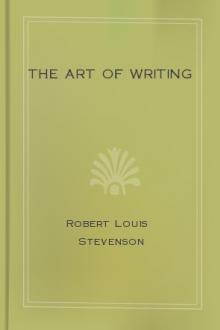The Art of Writing by Robert Louis Stevenson (read book .txt) 📕

- Author: Robert Louis Stevenson
- Performer: -
Book online «The Art of Writing by Robert Louis Stevenson (read book .txt) 📕». Author Robert Louis Stevenson
The Project Gutenberg EBook of The Art of Writing and Other Essays
by Robert Louis Stevenson
(#22 in our series by Robert Louis Stevenson)
Copyright laws are changing all over the world. Be sure to check the
copyright laws for your country before downloading or redistributing
this or any other Project Gutenberg eBook.
This header should be the first thing seen when viewing this Project
Gutenberg file. Please do not remove it. Do not change or edit the
header without written permission.
Please read the “legal small print,” and other information about the
eBook and Project Gutenberg at the bottom of this file. Included is
important information about your specific rights and restrictions in
how the file may be used. You can also find out about how to make a
donation to Project Gutenberg, and how to get involved.
**Welcome To The World of Free Plain Vanilla Electronic Texts**
**eBooks Readable By Both Humans and By Computers, Since 1971**
*****These eBooks Were Prepared By Thousands of Volunteers!*****
Title: The Art of Writing and Other Essays
Author: Robert Louis Stevenson
Release Date: April, 1996 [EBook #492]
[This file was first posted on February 21, 1996]
Edition: 10
Language: English
Character set encoding: ASCII
*** START OF THE PROJECT GUTENBERG EBOOK, THE ART OF WRITING ***
Transcribed from the 1905 Chatto & Windus edition by David Price,
email ccx074@coventry.ac.uk
ESSAYS IN THE ART OF WRITING
Contents:
On some technical elements of style in literature
The morality of the profession of letters
Books which have influenced me
A note on realism
My first book: ‘Treasure Island’
The genesis of ‘the master of Ballantrae’
Preface to ‘the master of Ballantrae’
ON SOME TECHNICAL ELEMENTS OF STYLE IN LITERATURE {1}
There is nothing more disenchanting to man than to be shown the
springs and mechanism of any art. All our arts and occupations lie
wholly on the surface; it is on the surface that we perceive their
beauty, fitness, and significance; and to pry below is to be
appalled by their emptiness and shocked by the coarseness of the
strings and pulleys. In a similar way, psychology itself, when
pushed to any nicety, discovers an abhorrent baldness, but rather
from the fault of our analysis than from any poverty native to the
mind. And perhaps in aesthetics the reason is the same: those
disclosures which seem fatal to the dignity of art seem so perhaps
only in the proportion of our ignorance; and those conscious and
unconscious artifices which it seems unworthy of the serious artist
to employ were yet, if we had the power to trace them to their
springs, indications of a delicacy of the sense finer than we
conceive, and hints of ancient harmonies in nature. This ignorance
at least is largely irremediable. We shall never learn the
affinities of beauty, for they lie too deep in nature and too far
back in the mysterious history of man. The amateur, in
consequence, will always grudgingly receive details of method,
which can be stated but never can wholly be explained; nay, on the
principle laid down in Hudibras, that
‘Still the less they understand,
The more they admire the sleight-of-hand,’
many are conscious at each new disclosure of a diminution in the
ardour of their pleasure. I must therefore warn that well-known
character, the general reader, that I am here embarked upon a most
distasteful business: taking down the picture from the wall and
looking on the back; and, like the inquiring child, pulling the
musical cart to pieces.
1. Choice of Words.—The art of literature stands apart from among
its sisters, because the material in which the literary artist
works is the dialect of life; hence, on the one hand, a strange
freshness and immediacy of address to the public mind, which is
ready prepared to understand it; but hence, on the other, a
singular limitation. The sister arts enjoy the use of a plastic
and ductile material, like the modeller’s clay; literature alone is
condemned to work in mosaic with finite and quite rigid words. You
have seen these blocks, dear to the nursery: this one a pillar,
that a pediment, a third a window or a vase. It is with blocks of
just such arbitrary size and figure that the literary architect is
condemned to design the palace of his art. Nor is this all; for
since these blocks, or words, are the acknowledged currency of our
daily affairs, there are here possible none of those suppressions
by which other arts obtain relief, continuity, and vigour: no
hieroglyphic touch, no smoothed impasto, no inscrutable shadow, as
in painting; no blank wall, as in architecture; but every word,
phrase, sentence, and paragraph must move in a logical progression,
and convey a definite conventional import.
Now the first merit which attracts in the pages of a good writer,
or the talk of a brilliant conversationalist, is the apt choice and
contrast of the words employed. It is, indeed, a strange art to
take these blocks, rudely conceived for the purpose of the market
or the bar, and by tact of application touch them to the finest
meanings and distinctions, restore to them their primal energy,
wittily shift them to another issue, or make of them a drum to
rouse the passions. But though this form of merit is without doubt
the most sensible and seizing, it is far from being equally present
in all writers. The effect of words in Shakespeare, their singular
justice, significance, and poetic charm, is different, indeed, from
the effect of words in Addison or Fielding. Or, to take an example
nearer home, the words in Carlyle seem electrified into an energy
of lineament, like the faces of men furiously moved; whilst the
words in Macaulay, apt enough to convey his meaning, harmonious
enough in sound, yet glide from the memory like undistinguished
elements in a general effect. But the first class of writers have
no monopoly of literary merit. There is a sense in which Addison
is superior to Carlyle; a sense in which Cicero is better than
Tacitus, in which Voltaire excels Montaigne: it certainly lies not
in the choice of words; it lies not in the interest or value of the
matter; it lies not in force of intellect, of poetry, or of humour.
The three first are but infants to the three second; and yet each,
in a particular point of literary art, excels his superior in the
whole. What is that point?
2. The Web.—Literature, although it stands apart by reason of the
great destiny and general use of its medium in the affairs of men,
is yet an art like other arts. Of these we may distinguish two
great classes: those arts, like sculpture, painting, acting, which
are representative, or, as used to be said very clumsily,
imitative; and those, like architecture, music, and the dance,
which are self-sufficient, and merely presentative. Each class, in
right of this distinction, obeys principles apart; yet both may
claim a common ground of existence, and it may be said with
sufficient justice that the motive and end of any art whatever is
to make a pattern; a pattern, it may be, of colours, of sounds, of
changing attitudes, geometrical figures, or imitative lines; but
still a pattern. That is the plane on which these sisters meet; it
is by this that they are arts; and if it be well they should at
times forget their childish origin, addressing their intelligence
to virile tasks, and performing unconsciously that necessary
function of their life, to make a pattern, it is still imperative
that the pattern shall be made.
Music and literature, the two temporal arts, contrive their pattern
of sounds in time; or, in other words, of sounds and pauses.
Communication may be made in broken words, the business of life be
carried on with substantives alone; but that is not what we call
literature; and the true business of the literary artist is to
plait or weave his meaning, involving it around itself; so that
each sentence, by successive phrases, shall first come into a kind
of knot, and then, after a moment of suspended meaning, solve and
clear itself. In every properly constructed sentence there should
be observed this knot or hitch; so that (however delicately) we are
led to foresee, to expect, and then to welcome the successive
phrases. The pleasure may be heightened by an element of surprise,
as, very grossly, in the common figure of the antithesis, or, with
much greater subtlety, where an antithesis is first suggested and
then deftly evaded. Each phrase, besides, is to be comely in
itself; and between the implication and the evolution of the
sentence there should be a satisfying equipoise of sound; for
nothing more often disappoints the ear than a sentence solemnly and
sonorously prepared, and hastily and weakly finished. Nor should
the balance be too striking and exact, for the one rule is to be
infinitely various; to interest, to disappoint, to surprise, and
yet still to gratify; to be ever changing, as it were, the stitch,
and yet still to give the effect of an ingenious neatness.
The conjurer juggles with two oranges, and our pleasure in
beholding him springs from this, that neither is for an instant
overlooked or sacrificed. So with the writer. His pattern, which
is to please the supersensual ear, is yet addressed, throughout and
first of all, to the demands of logic. Whatever be the
obscurities, whatever the intricacies of the argument, the neatness
of the fabric must not suffer, or the artist has been proved
unequal to his design. And, on the other hand, no form of words
must be selected, no knot must be tied among the phrases, unless
knot and word be precisely what is wanted to forward and illuminate
the argument; for to fail in this is to swindle in the game. The
genius of prose rejects the cheville no less emphatically than the
laws of verse; and the cheville, I should perhaps explain to some
of my readers, is any meaningless or very watered phrase employed
to strike a balance in the sound. Pattern and argument live in
each other; and it is by the brevity, clearness, charm, or emphasis
of the second, that we judge the strength and fitness of the first.
Style is synthetic; and the artist, seeking, so to speak, a peg to
plait about, takes up at once two or more elements or two or more
views of the subject in hand; combines, implicates, and contrasts
them; and while, in one sense, he was merely seeking an occasion
for the necessary knot, he will be found, in the other, to have
greatly enriched the meaning, or to have transacted the work of two
sentences in the space of one. In the change from the successive
shallow statements of the old chronicler to the dense and luminous
flow of highly synthetic narrative, there is implied a vast amount
of both philosophy and wit. The philosophy we clearly see,
recognising in the synthetic writer a far more deep and stimulating
view of life, and a far keener sense of the generation and affinity
of events. The wit we might imagine to be lost; but it is not so,
for it is just that wit, these perpetual nice contrivances, these
difficulties overcome, this double purpose attained, these two
oranges kept simultaneously





Comments (0)